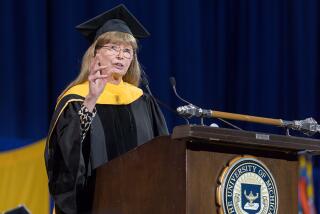THE CUTTING EDGE: COMPUTING / TECHNOLOGY / INNOVATION : Who and What Made PARC an Industry Legend : Computers: Other firms could learn from the things the Xerox Palo Alto Research Center did right.
- Share via
SAN FRANCISCO — A computer research manager at Microsoft Corp. was recently contemplating how to spur greater creativity in his group when he hit upon a most unlikely solution: beanbag chairs. These quintessentially ‘70s pieces of leisure furniture were the seats of choice during the most remarkable run of inventive brilliance the computer industry had ever seen, he reasoned, and perhaps, to paraphrase a famous sneaker commercial, “it’s the chairs.”
Not surprisingly, the Microsoft beanbags were soon stacked in a dusty corner. But the originals, where the researchers at Xerox’s Palo Alto Research Center sat as they tossed around technical ideas that were to change the world, are now on display at the Smithsonian Institution.
As Xerox PARC opens its 25th anniversary celebration today Microsoft and the other companies that are now leading the information technology revolution would do well to take heed of the real secrets of PARC’s success. For in the course of just a few years, PARC scientists came up with three seminal innovations, each of which has proven central to the contemporary computer industry: the graphical user interface, the laser printer, and the Ethernet computer network.
And even though it appears that the contemporary technology industry is spitting forth innovations at a furious pace, it is actually heavily reliant on fundamental inventions that are several decades old. Many fear that cutbacks in funding for basic research, on the part of both government and industry, will ultimately stall the industry’s progress.
What made PARC possible was, in the first instance, a company wealthy and confident enough to sponsor basic research--an increasingly rare commodity in the hyper-competitive, cost-cutting 1990s. And Xerox was also wise enough to give its researchers a broad but tangible goal: Invent the office of the future.
Another critical factor, naturally enough, was some exceptionally brilliant scientists. But perhaps most important of all was extraordinary group chemistry, a way of working collectively that rendered the whole greater than its already-great parts. Much of the credit for that must go to an exceptional manager: Bob Taylor, a football-loving Texan whose master’s degree was not in computer science but in psychology.
“Lots of labs hire really good people,” notes Gordon Bell, the legendary designer of the VAX minicomputer and now a researcher at Microsoft. “What was different at PARC was that you had the whole lab working on one project. This is something that’s very hard to do. . . . Universities don’t train people to work together. They work in isolation on one piece of a problem.”
*
The irony of PARC’s achievements is that Xerox had no idea what to do with the labs’ innovations. Many of the scientists, after realizing that Xerox was allowing their inventions to languish, walked out to start their own companies. Xerox, which did not hold patents or copyrights on the technology, could do little to stop them. And it was not until Apple launched the Macintosh computer did PARC’s biggest ideas find expression in a product.
There were some bitter feelings toward Xerox at the time, but today most of the scientists are nostalgic about their PARC years. Time, and the fortunes that many have made off their PARC inventions, have done much to fade any negative memories.
“It was wonderful,” said Bob Metcalfe, who went on to found networking vendor 3Com Corp. and is today editorial director for Infoworld Publishing, a division of International Data Corp. “I got paid much better than I would have if I had taken a job at a university. If I had to travel for a business meeting I flew first class, and I was given all the equipment I would ever need to do my work. Best of all, I got to work with other geniuses.”
PARC got its start in 1970 when Xerox, rolling in cash from its monopoly on the copier business, decided to try to develop a long-term view of where its business might be going. It decided to establish a new research facility in Silicon Valley, near Stanford University and UC Berkeley and far from the potentially stultifying Xerox bureaucracy in Stamford, Conn. There were actually three separate labs--a computer science lab, a general science lab, and a systems research lab for software development--but the computer science lab quickly established itself as the jewel.
To lead the effort, Xerox found an unlikely character in Taylor. He had been a manager with the Defense Department’s Advanced Research Projects Agency, itself something of a font of innovation, and thus knew many of the leading computer scientists in the country.
Taylor had a remarkable knack for finding good people. Many of his early hires are industry legends such as Alan Kay, today an Apple research fellow; Butler Lampson, a senior researcher at Microsoft, and Chuck Thacker, a senior researcher for Digital Equipment Corp. They all shared the vision of a computer for individuals that would also allow their owners to collaborate with others in the workplace.
Eventually the lab numbered some 70 researchers, all of them reporting directly to Taylor. They thought of him, if not as a father, then as a big brother. “When I got hired at Xerox, I didn’t have a green card,” says Hungarian emigre Charles Simonyi, now a researcher at Microsoft. “Bob helped me with the immigration people. He taught me how to play touch football. . . . He thought of me as more than a computing resource.”
“It was odd that he became the spiritual leader. He had come from University of Texas or some damn place like that,” says Harvard alumnus Metcalfe. “But he would do anything for you.
“Most of the people in the lab weren’t comfortable in social settings, myself included,” he continues. “Bob was gregarious, a real people person. He hosted these parties and made us feel comfortable, and maybe we were grateful to him for that.”
But Taylor was anything but a dictatorial boss: All decisions were made at the lab’s weekly “dealer” meetings, where researchers presented their ideas to their colleagues. Taylor called them “dealers,” because, as in poker, the dealer sets the ground rules for the game--or in this case, the discussion.
*
At the dealers, the audience was encouraged to challenge the speaker--a seemingly simple format that other companies have tried, with little success, to re-create. At chip giant Intel Corp., for example, they’ve coined the term constructive confrontation, which often turns meetings into battlegrounds in which warring employees can attack one another publicly. At PARC, since there was little advantage in attacking a peer, it rarely happened.
“These people were really arch-nerds,” says PARC alumnus Mike Schroeder, now a researcher at Digital Equipment Corp. “All they cared about was technology, not whether or not they got a good office.”
“Peer review has to be fair, and it has to attack ideas rather than the individual,” Taylor said. “Even so, when people would come and visit us from Xerox corporate, they would be shocked at the way we talked to one another because we were so frank.”
The sessions served to weed out flawed projects and kept scientists updated on their colleagues’ work.
It also strengthened the group’s esprit de corps. Dealers were used for hiring: Candidates presented their research to the group, which was then able to ask questions. “When I interviewed, one of the scientists fell asleep, and I was crushed,” says Chuck Geschke, a former PARC researcher who is now president of Adobe Systems. “I later found out that he had been up for 36 hours.”
Most remember the sessions as intellectually invigorating. “Although they could be perceived as confrontational, they really weren’t,” says Adele Goldberg, now chairman of software maker ParcPlace Systems. “It was more like, ‘Hey you’ve talked about something really interesting, let’s get into it more deeply. To this day, if I give a presentation and everyone applauds politely at the end of it, I think that something’s wrong--I’ve bored them.”
*
But not all thrived in the spotlight. “There are some people in the world--some good people--who couldn’t adapt to the abrasive style that was practiced,” Lampson admits. “Those people didn’t last.”
PARC’s biggest problems came when it tried to communicate its vision to parent Xerox. The feeling on the part of the researchers was that the brilliance of their work spoke for itself, and they saw no need to sell their ideas to corporate.
Geschke remembers a technology exposition held by PARC researchers for Xerox’s top management in 1977 that proved to be a foreshadowing of fractious relations between its spirited lab and Xerox’s staid executives.
“We had brought all our equipment to Boca Raton, where Xerox management was holding a company-wide meeting,” Geschke recalls. “We set it up for them. I could tell within minutes that they didn’t understand. It was in their body language: Their arms were folded tightly across their chests, and there were scowls on their faces.”
By the late 1970s, Xerox, facing competition in its copier business from the Japanese, began to feel that PARC was a luxury it could not afford, and the budget began to get squeezed. In 1983, Taylor, who was perceived as caring about PARC at the expense of the parent company, was eased out. Today, PARC’s work is mostly conventional applied research focusing on the copier business: only 20% of the research is now open-ended.
“The business pressures have forced all of us to do a little less basic research,” says Bob Spinrad, vice president of technology strategy at PARC. PARC inventions, of course, live on. Apple co-founder Steven Jobs was perhaps the most important popularizer of the technologies, taking the idea of the graphical interface--featuring icons, overlapping windows, and a mouse--and creating the computer that was to become the Macintosh. Microsoft, in turn, borrowed heavily from Apple in creating Windows.
Apple, Adobe and others have helped to create the PARC-inspired desktop publishing industry. 3Com and others have popularized Ethernet networks.
But nobody has succeeded in recreating the PARC magic. At Microsoft they have the beanbag chairs, but the company’s culture is too aggressive and marketing oriented to accommodate an operation like PARC. Interval Research, funded by Microsoft co-founder Paul Allen, is run by PARC alumnus David Liddle, and he has hired a number of his former PARC colleagues and instituted some of the research center’s conventions.
But Charles Irby, who left Xerox with Liddle in the early 1980s to start Metaphor Computer--now a subsidiary of IBM--was recently wooed by his former partner, and he didn’t see much resemblance to the old days.
“It looks like PARC, only everyone has grayed,” Irby says. “But it didn’t feel like PARC, because the argumentative personalities aren’t there. It felt less vibrant.” Irby turned the job down in favor of a position at Silicon Graphics Inc.
More to Read
Inside the business of entertainment
The Wide Shot brings you news, analysis and insights on everything from streaming wars to production — and what it all means for the future.
You may occasionally receive promotional content from the Los Angeles Times.










